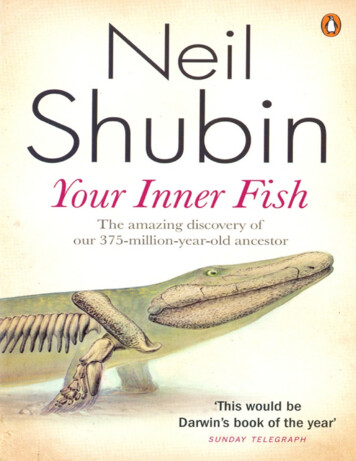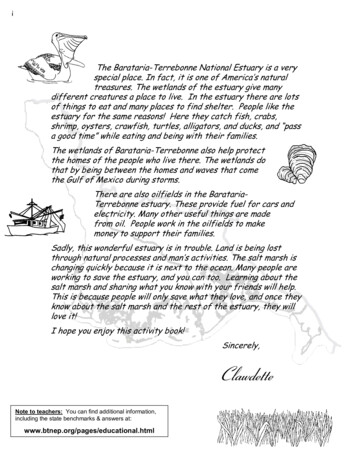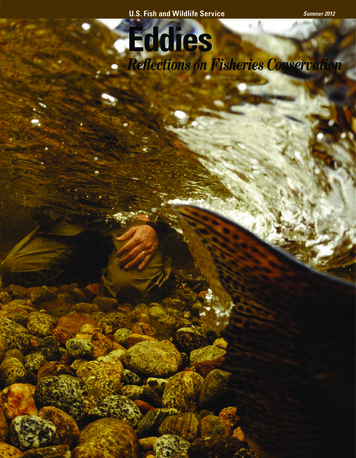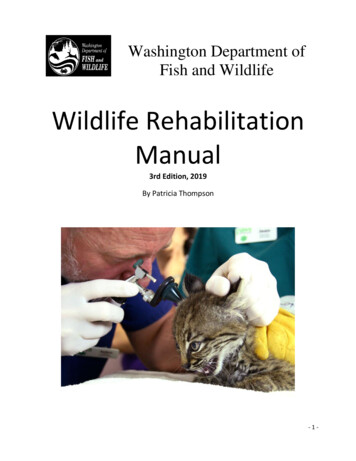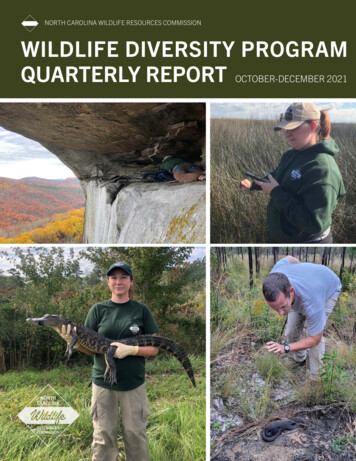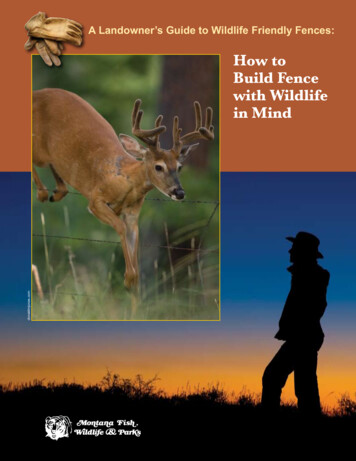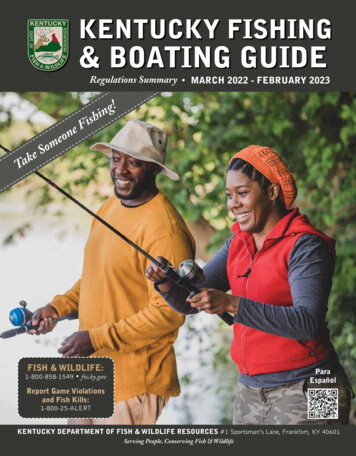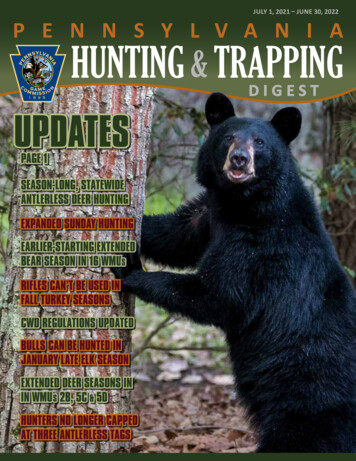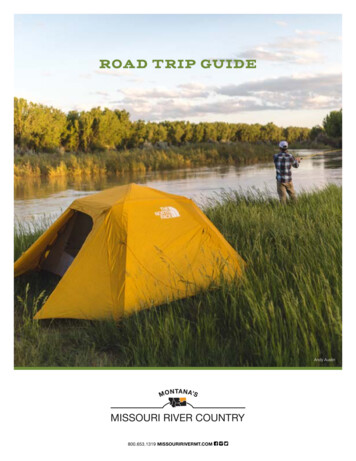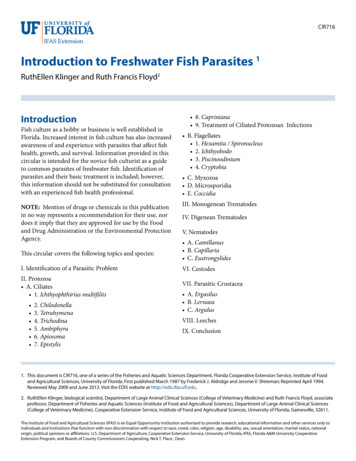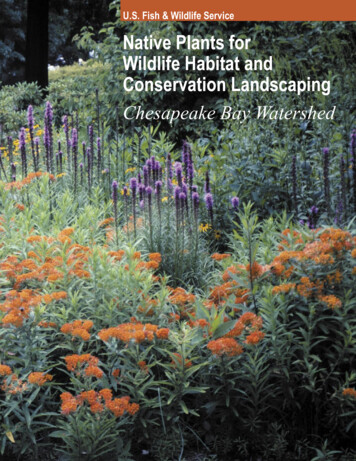
Transcription
U.S. Fish & Wildlife ServiceNative Plants forWildlife Habitat andConservation LandscapingChesapeake Bay Watershed
AcknowledgmentsContributors: Printing was made possible through the generous funding from Adkins Arboretum;Baltimore County Department of Environmental Protection and Resource Management; ChesapeakeBay Trust; Irvine Natural Science Center; Maryland Native Plant Society; National Fish and WildlifeFoundation; The Nature Conservancy, Maryland-DC Chapter; U.S. Department of Agriculture, NaturalResource Conservation Service, Cape May Plant Materials Center; and U.S. Fish and Wildlife Service,Chesapeake Bay Field Office.Reviewers: species included in this guide were reviewed by the following authorities regarding nativerange, appropriateness for use in individual states, and availability in the nursery trade:Rodney Bartgis, The Nature Conservancy, West Virginia.Ashton Berdine, The Nature Conservancy, West Virginia.Chris Firestone, Bureau of Forestry, Pennsylvania Department of Conservation and Natural Resources.Chris Frye, State Botanist, Wildlife and Heritage Service, Maryland Department of Natural Resources.Mike Hollins, Sylva Native Nursery & Seed Co.William A. McAvoy, Delaware Natural Heritage Program, Delaware Department of Natural Resourcesand Environmental Control.Mary Pat Rowan, Landscape Architect, Maryland Native Plant Society.Rod Simmons, Maryland Native Plant Society.Alison Sterling, Wildlife Resources Section, West Virginia Department of Natural Resources.Troy Weldy, Associate Botanist, New York Natural Heritage Program, New York State Department ofEnvironmental Conservation.Graphic Design and Layout: Laurie Hewitt, U.S. Fish and Wildlife Service, Chesapeake Bay FieldOffice.Special thanks to: Volunteer Carole Jelich; Christopher F. Miller, Regional Plant Materials Specialist,Natural Resource Conservation Service; and R. Harrison Weigand, Maryland Department of NaturalResources, Maryland Wildlife and Heritage Division for assistance throughout this project.Citation: Slattery, Britt E., Kathryn Reshetiloff, and Susan M. Zwicker. 2003. Native Plants for WildlifeHabitat and Conservation Landscaping: Chesapeake Bay Watershed. U.S. Fish & Wildlife Service,Chesapeake Bay Field Office, Annapolis, MD. 82 pp.2003
Table of ContentsIntroductionBenefits of Conservation Landscaping . 3Why Use Native Plants . 4Conservation Landscaping Elements . 4How to Choose Plants . 6Where to Find Native Plants . 6How To Use This GuidePlant Names and Types . 7Characteristics . 7Growth Conditions . 8Habitat . 9Native To (Where to Use) . 9Wildlife Value . 10Notes . 10Plant Information PagesFerns .11Grasses & Grasslike Plants . 14Herbaceous Plants . 18Herbaceous Emergents . 41Shrubs . 45Trees. 54Vines . 64Plants with a PurposePlants for Coastal Dunes . 66Plants for Saltwater or Brackish Water Marshes . 66Plants for Freshwater Wetlands and Other Wet Sites . 67Plants Appropriate for Bogs or Bog Gardens . 68Plants for Dry Meadows . 68Plants for Wet Meadows . 69Plants for Forest or Woodland Plantings . 69Solutions for Slopes. 71Evergreens . 72Plants to Use as Groundcovers . 72Plants for Spring and Fall Color . 72Deer Resistant Plants . 73Photo Credits . 74References . 75Index . 791
To the ReaderThe use of native plants in landscaping and of course habitat restoration is certainly not new.In fact, their use has grown exponentially in recent years. Natural resources professionals inturn have been flooded with requests for information on native plants to use in various types ofplanting projects. Communities, schools, businesses, nonprofit organizations, watershed groups,local governments, state and federal agencies and many others are enhancing and restoringhabitat, solving ecological problems, reducing maintenance, or just beautifying surroundings,all using locally native plants. Natural resources professionals, in turn, have been flooded withrequests for information on native plants to use in various types of planting projects. There aremany excellent resources available on native plants - some more technical than others, somemore comprehensive than others. The frustration voiced most frequently by users is the lack ofcolor photographs of the plants. After all, it is the striking visual quality of these plants that is theirbest “selling point.”This publication includes those pictures as well as user-friendly information on native speciesappropriate for planting in the Chesapeake Bay watershed and adjacent coastal regions.Although one guide cannot furnish the answers to every question, we have included as muchuseful information as possible in a limited space. Although the large number of species ofplants included here may overwhelm some readers, this guide displays the great diversity ofplants available. We hope you will bypass the over-used, non-native and sometimes invasiveornamental plants, and select the equally and often more attractive native plants. Pour throughthis guide the same way you look through nursery catalogs. Use it to plan and design your nextplanting, whether it’s a small corner of your front yard, a two-acre meadow seeding, or 100 acresof wetland restoration.2
Native Plants for Wildlife Habitat andConservation Landscaping:Chesapeake Bay WatershedIntroduction“Conservation landscaping” refers to landscaping with specific goals of reducing pollution andimproving the local environment. In the Chesapeake Bay watershed (the land that drains to theBay and its many tributaries), this style of landscaping is sometimes called “BayScaping,” orbeneficial landscaping.Conservation landscaping provides habitat for local and migratory animals, conserves nativeplants and improves water quality. Landowners also benefit as this type of landscaping reducesthe time and expense of mowing, watering, fertilizing and treating lawn and garden areas, andoffers greater visual interest than lawn. Beneficial landscaping can also be used to address areaswith problems such as erosion, poor soils, steep slopes, or poor drainage.One of the simplest ways to begin is by replacing lawn areas with locally native trees, shrubs andperennial plants. The structure, leaves, flowers, seeds, berries and other fruits of these plantsprovide food and shelter for a variety of birds and other wildlife. The roots of these larger plantsare also deeper than that of typical lawn grass, and so they are better at holding soil and capturingrainwater.Benefits of conservation landscapingAmericans manage approximately more than 30 million acres of lawn. We spend 750 millionper year on grass seed. In managing our yards and gardens, we tend to over-apply products,using 100 million tons of fertilizer and more than 80 million pounds of pesticides annually. Theaverage homeowner spends 40 hours per year behind a power mower, using a quart of gas perhour. Grass clippings consume 25 to 40% of landfill space during a growing season. Per hour ofoperation, small gas-powered engines used for yard care emit more hydrocarbon than a typicalauto (mowers 10 times as much, string trimmers 21 times, blowers 34 times). A yard with 10,000square feet of turf requires 10,000 gallons of water per summer to stay green; 30% of waterconsumed on the East Coast goes to watering lawns.The practices described in this guide reduce the amount of intervention necessary to haveattractive and functional landscaping. Conventional lawn and garden care contributes to pollutionof our air and water and uses up non-renewable resources such as fuel and water. Many typicallandscapes receive high inputs of chemicals, fertilizers, water and time, and require a lot ofenergy (human as well as gas-powered) to maintain. The effects of lawn and landscaping on theenvironment can be reduced if properties are properly managed by using organic alternativesapplied correctly, decreasing the area requiring gas-powered tools, using native species thatcan be sustained with little watering and care, and using a different approach to maintenancepractices.With conservation landscaping, there is often less maintenance over the long term, while stillpresenting a “maintained” appearance. Conservation landscapes, like any new landscape, willrequire some upkeep, but these alternative measures are usually less costly and less harmfulto the environment. New plants need watering and monitoring during the first season until theybecome established. Disturbed soil is prone to invasion by weeds - requiring manual removal(pulling) instead of chemical application. Over time, desired plants spread to fill gaps andnatural cycles help with pest control. Garden maintenance is reduced to only minimal seasonalcleanup and occasional weeding or plant management. The savings realized by using little orno chemicals, and less water and gas, can more than make up for initial costs of installing thelandscaping. Redefining landscaping goals overall and gradually shifting to using native speciesprovide even greater rewards in terms of environmental quality, landscape sustainability, improvedaesthetics, cost savings, and bringing wildlife to the property.3
Why use native plants?Native plants naturally occur in the region in which they evolved. While non-native plants mightprovide some of the above benefits, native plants have many additional advantages. Becausenative plants are adapted to local soils and climate conditions, they generally require less wateringand fertilizing than non-natives. Natives are often more resistant to insects and disease as well,and so are less likely to need pesticides. Wildlife evolved with plants; therefore, they use nativeplant communities for food, cover and rearing young. Using native plants helps preserve thebalance and beauty of natural ecosystems.This guide provides information about native plants that can be used for landscaping projects aswell as large-scale habitat restoration. All of the plants presented are native to the designatedareas, however not all of the native species for that area have been included. Rather, plants havebeen included because they have both ornamental and wildlife value, and are generally availablefor sale. This guide covers the entire Chesapeake Bay watershed, including south central NewYork; most of Pennsylvania, Maryland and Virginia; the District of Columbia; Delaware, west ofDelaware Bay; and the eastern panhandle of West Virginia.The region’s wildlife, plants, habitats and network of streams and rivers leading to the Bay aretremendous resources. As the human population throughout the Chesapeake Bay watershedgrows and land-use pressures intensify, it is increasingly important to protect our remainingnatural areas and wildlife, and restore and create habitat. By working together, these treasurescan be conserved for future generations. Individual projects are great, collective measures areeven better, yet every action helps no matter what size.Conservation landscaping elementsWe can incorporate elements of natural systems into the existing areas where we live, work,learn, shop and play. Landscaping provides valuable opportunities to reduce the effects of thebuilt environment. These areas can be both aesthetically pleasing and functional. Use of nativespecies will make your garden or landscaping more environmentally beneficial. By combiningplant selection with some of the other concepts below, you can achieve more environmentalbenefits.Reduce disturbance. Carefully decide where new development will occur to avoid destruction ofexisting habitat as much as possible. Take advantage of the site’s existing natural features.Reduce lawn or high maintenance areas. Replace turf or ornamental plantings by adding newlandscaping beds and/or enlarge existing ones with native plants.Think big, but start small. Draw up a plan for your entire yard but choose one small area foryour first effort. Trial and error with the first project will help you learn without being overwhelmed.Phase in the whole project over time.Use native plants. Start by using natives to replace dead or dying non-native plants, or as asubstitute for invasive non-natives in existing gardens or landscaping. Plan to use native plants innew landscaping projects.Avoid invasive species. Non-native plants can be invasive. They have few or no naturallyoccurring measures to control them, such as insects or competitors. Invasive plants can spreadrapidly and smother or out-compete native vegetation. Invasive, non-native plants are not effectivein providing quality habitat. A copy of the publication “Plant Invaders of Mid Atlantic Natural Areas”can be downloaded from m.Improve water quality. Native species planted on slopes, along water bodies and along drainageditches help prevent erosion and pollution by stabilizing the soil and slowing the flow of rainwaterrunoff. To collect and filter runoff, depressions can be created and planted with native plants suitedto temporary wet conditions. These “rain gardens” will capture water and hold it temporarily for a4In certain conditions, some native plants canalso become aggressive spreaders, thoughtheir spread is more limited by natural controlsthan non-native aggressors. Plants that seedreadily (such as black-eyed Susan, Rudbeckiaspecies), or that spread by lateral roots (suchas mint family plants Monarda or Physostegiaspecies) should be used sparingly or controlledin gardens. Certain native species that aredifficult to control or show up uninvited shouldnot be planted, such as cattail (Typha species).
day or two and remove pollutants washing off of the surrounding land.Enhance and create wildlife habitat. An animal’s habitat is the area where it finds food, water,shelter, and breeding or nesting space, in a particular arrangement. If we want our gardens tohave the greatest ecological value for wildlife, we need to mimic natural plant groupings andincorporate features that provide as many habitat features as possible.Plants are one of the most important features of an animal’s habitat, because they often providemost, or even all of the animal’s habitat needs. Animals in turn help plants to reproduce throughdispersal of pollen, fruits or seeds. Consequently, plants and animals are interdependent andcertain plants and animals are often found together. So, it is important that plants be selected,grouped, and planted in a way that is ecologically appropriate.Each plant prefers or tolerates a range of soil, sunlight, moisture, temperature and otherconditions, as well as a variety of other factors including disturbance by natural events, animalsor human activities. Plants sharing similar requirements are likely to be found together in plantcommunities that make up different habitat types - particular groupings of plant communitiescommonly recognized as wetlands, meadows, forests, etc. Some plants may tolerate a widerrange of conditions than others, and therefore can be found at more than one type of site, inassociation with a different set of plants at each. By matching plants with similar soil, sunlight,moisture and other requirements, and planting them to the existing site conditions, the plantedlandscapes will do a good job of approximating a natural habitat.Instead of isolated plantings, such as a tree in the middle of lawn, group trees, shrubs andperennials to create layers of vegetation. A forest has, for example, a canopy layer (tallest trees),understory layers (various heights of trees and shrubs beneath the canopy) and a ground layer orforest floor. These layers provide the structure and variety needed for shelter, breeding or nestingspace for a diversity of wildlife.To provide food and cover for wildife year-round, include a variety of plants that produce seeds,nuts, berries or other fruits, or nectar; use evergreens as well as deciduous plants (those thatlose their leaves); and allow stems and seedheads of flowers and grasses to remain standingthroughout fall and winter.All animals need water year-round to survive. Even a small dish of water, changed daily to preventmosquito growth, will provide for some birds and butterflies. Puddles, pools or a small pond canbe a home for amphibians and aquatic insects. A larger pond can provide for waterfowl, suchas ducks and geese, and wading birds such as herons. Running or circulating water will attractwildlife, stay cleaner and prevent mosquitoes.Rock walls or piles, stacked wood, or brush piles provide homes for insects, certain birds andsmall mammals. Fallen logs and leaf litter provide moist places for salamanders, and the manyorganisms that recycle such organic matter, contributing nutrients to the soil. Standing dead treetrunks benefit cavity-nesting wildlife such as woodpeckers.Consider naturalistic planting, or habitat restoration. It may be feasible to create a morenatural landscape instead of a formal one. Naturalistic landscaping uses patterns found in nature,and allows some nature-driven changes to occur. Plants multiply, and succession or gradualreplacement of species may take place, with less human intervention. A property located nearnatural areas, such as forests, wetlands and meadows, is a good candidate for a habitat project.Expand existing forest by planting trees and shrubs along the woods line, using native speciesthat grow in the area, and allow birds and wind to bring the understory plants over time. Wet sites,areas with clay soils, or drainage ditches can be converted to wetlands. An open piece of groundor lawn can be planted as a meadow or grassland. Schools, homes, small businesses, largecorporate sites, municipalities, military installations, recreational areas and other public lands canall include habitat plantings.5
How to choose plantsFinding ready information about what plants “go together” for habitat restoration, enhancement,or creation projects is difficult. Often, the professional will examine a nearby natural area and tryto mimic the combination of plant species found there. That may not be possible for individualsunfamiliar with natural areas. Fortunately, by following some simple guidelines, you will havegarden spaces that grow well on your site and mirror the plant communities found naturally inyour area. The plant lists found at the end of this guide will also help give you a start at plantingappropriate groupings. Know your site and plant to the existing site conditions. Check the sun exposure, soilmoisture and soil type where you plan to plant, and choose plants that will grow and thrivein those conditions. For a few dollars your state or local cooperative extension office cananalyze a small soil sample you send them (for contact information, see your governmentlistings in the phone book). The results will include soil type (sand, clay, loam, etc.), pH andfertility status and recommendations for amending the soil to make it into “average gardensoil.” However, by selecting native species that thrive in the existing conditions, you won’tneed to add soil, fertilizer, lime or compost. There are a wide variety of plants that will thrivein most conditions, even the driest, poorest soil or very wet clay soil. If, however, the soiltest shows extreme pH - very acidic (pH of less than 5) or very basic (pH 8 or above), yourplant choices will be fairly limited. In that case, you might choose to follow the instructions formaking the soil more neutral. If the soil is hard, compacted fill dirt, you might want to improveit by adding organic matter and work the ground so that it can more easily be planted. If youalter the site, then select plants suited to the new conditions.Choose plants native to your region of your state. Along with planting to the existingsite conditions, use locally native plants. Use the map on page 9 to identify which physiogeographic region the planting site lies in. If you’re close to a border dividing two regions,you may choose plants from either or both regions.Choose a habitat type. Try to create or emulate a specific habitat, like woods, wetlandor meadow, and choose plants that are appropriate to both your site and the habitat. Lookthrough this guide and mark the plants with growth requirements that match conditions at theplanting site. This will help improve the success of your planting, the habitat value, and theecological functioning of the project. This publication will eventually be made available online,in a format that can be electronically sorted by plant characteristics or growth conditions.Where to find native plantsMost nurseries carry some native plants, and some nurseries specialize and carry a greaterselection. As the demand for native plants has grown, so has the supply at nurseries. Some plantswill be more readily available than others. Here, we’ve focused on species most appropriate forplanting and available through the nursery trade. A limited number of species included here arenot commonly available but are able to be nursery grown. Take this guide along with you whenyou visit nurseries and if you need help, ask for nursery staff familiar with native plants. If you seea plant you like, check to see if it’s included in the guide for your state and physiographic region.For those species that are more difficult to find, the hope and intention is that this publication willspark a demand, and hence a greater supply. If you have a favorite plant that you can’t obtain, besure to ask your local nursery to consider adding it to their stock. A list of some of the many retailand wholesale native plant nurseries in the Chesapeake Bay region is available from the U.S. Fishand Wildlife Service, Chesapeake Bay Field Office at www.fws.gov/r5cbfo/bayscapes.htm.For the greatest ecological value, select the “true” native species, especially if planting for wildlifebenefit. There are cultivated varieties (cultivars) available for many native plants. These arenamed using the scientific name (Latin genus and species, such as Rudbeckia fulgida) plus thecultivar name, a third word in single quotation marks (such as Rudbeckia fulgida ‘Goldsturm’).These varieties have been grown to provide plants with certain physical characteristics, perhapsa different flower color, different foliage or a compact shape or size. Although these are suitablefor gardening use, use true species (not cultivars) if you are planning a habitat project to provide6
food for wildlife. These plants are most suited to use by the native wildlife, and will increase yourchances of attracting them.Native plants should never be removed from the wild unless an area is about to be developed.Even then, it is difficult to transplant wild-collected plants and to duplicate their soil and othergrowth requirements in a home garden. Plants that are grown from seed or cuttings by nurserieshave a much greater tolerance for garden conditions. Help to preserve natural areas bypurchasing plants that have been grown, not collected.Ask nurseries about the source of the native species sold. Did they come from seed or cuttingsof plants found growing locally, or are they from another region? Ideally, the plants you useshould come from stock from the same region, say, within about a 200-mile radius in the samephysiographic province (coastal plain, Piedmont, or mountain). Differences exist from region toregion even in the same plant species, due to differences in climactic conditions between distantlocations. For example, a plant grown in Maine may flower at a different time than the samespecies grown in Maryland. They may have slight physical differences. These characteristicsmake a difference in designing gardens and they matter to wildlife seeking food sources. Themore consumers ask for locally grown plants or seed, the more likely it is that nurseries will carrylocal stock.Once you begin to explore and experiment with native plants, you’ll soon discover that manyof these plants go beyond just replacing worn out selections in your yard. Native plants willeventually reduce your labor and maintenance costs while inviting wildlife to your yard helping tocreate your own sense of place.How to use this guidePlant Names and TypesPlants are organized within each section alphabetically by scientific name. All scientific plantnames used are based on names accepted by ITIS, the Integrated Taxonomic InformationSystem. Plants are indexed at the back of the book by scientific as well as frequently usedcommon names. Scientific names are changed periodically as new information is gathered; forthose commonly recognized names that changed during development of this guide, the newnames are used here, with a cross reference noted in the index. For example: Aster divaricatus isnow Eurybia divaricata, so the plant is listed in the index under both Aster and Eurybia.Plants are grouped by botanical categories: Ferns; Grasses & Grasslike Plants (includes grassesand plants with long slender leaves that may appear similar to a grass); Herbaceous Plants(includes flowers and groundcovers); Herbaceous Emergents (plants that grow in moist to wetsoils, wetlands or in standing water with roots and part of their stems below water but with most ofthe plant above the water); Shrubs; Trees; and Vines.A note about groundcovers: English ivy, periwinkle, creeping lily turf and Japanese pachysandraare some commonly used groundcovers, particularly for shade. However, these species are nonnatives that are invasive in the landscape, so they should be avoided. What native alternativescan be used instead? A groundcover can be any plant that would physically cover or hide thebare ground from view. For the purposes of environmentally beneficial landscaping and habitatenhancement, any plant in the “herbaceous”category would make a good groundcover. For thosegardeners and landscapers still seeking a low-growing, creeping, spreading, or clump-formingplant for a groundcover, these plants are marked with asymbol in the Notes column and a listis included at the end of the guide.Characteristics Height and/or Spread The typical mature height or possible range of heights is given infeet, to the nearest half (0.5) foot. Height may vary depending on conditions (e.g., amountof moisture or sun). For trees and vines, spread is also given in feet. For trees, spread is themeasurement of the crown of the plant; for vines, spread is the length a vine will grow alonga surface.7
Flowers: bloom period and flower color The typical months in which the plant blooms aregive
for sale. This guide covers the entire Chesapeake Bay watershed, including south central New York; most of Pennsylvania, Maryland and Virginia; the District of Columbia; Delaware, west of Delaware Bay; and the eastern panhandle of West Virginia. The region's wildlife, plants, habitats and network of streams and rivers leading to the Bay are
